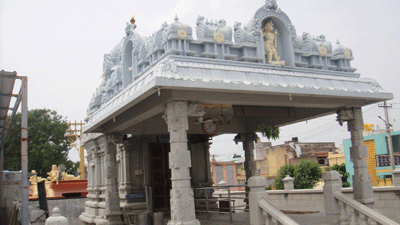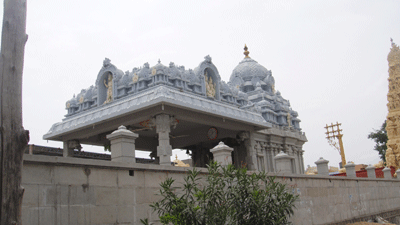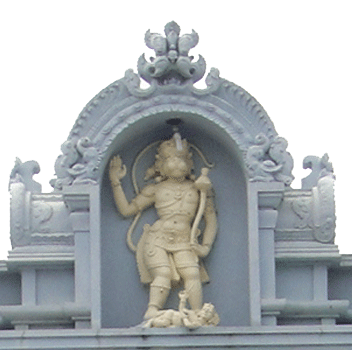
Chittoor
Chittoor was in a strategic position connecting the provinces of Tamil, Telugu, and Kannada-speaking regions. Therefore the British found it to be an important place to be developed. It was initially made the headquarters for the then-North Arcot district. During the British rule in the early twentieth century, seeing the importance of the place, a separate district in the name of Chittoor was formed with Chittoor as headquarters.
It should be mentioned that there is no special mention of the present town of Chittoor in any of the inscriptions or other historical records. The exception was that the British called for a meeting of Poligars in the town of Chittoor during mid-1804. There are lots of inscriptions in places like Tirupati, Kalahasti, etc in the present district giving us a lot of information about the rulers who held a position of power over an area covering Chittoor.
Name any dynasty of South India that had this region under their rule. Before the British, the Vijayanagar dynasty was the last significant ruler. In the middle of the 16th Century, Vijayanagar Kingdom fell into pieces. Members of the royal family started ruling territories where they could sway. Different territories came under the rulers who held titles of Zamindar or Poligar. There were ten Poligars who were powerful in the region.
Fort of Chittoor
The region came under the Nawab of Arcot's rule during the early 18th century. Since the region acted as a barrier for the invaders Chittoor was known as khilla in Arcot’s parleys. It is said that Abdul Wahab was the Khilladar of Chittoor for Nawab of Arcot. It is worthy to note that Hyder Ali the de-facto ruler of Mysore, had his initial training under Abdul Wahab.
During 1780 Sir Eyre Coote, of British and Hyder were at loggerhead to control this region. With Wandawashi in the pocket, the British advanced further towards Tirupati. Hyder had to retreat from Vellore unable to face the fire from British force. Coote then marched to Tiruttani via Polur destroying all small forts. Coote advanced to Chittoor and reduced its little fortress, deemed vital as it was reported to be a depot for provision. It was, however, found after its capture that its importance as a depot was false.
This is the only evidence we get that there existed a fort in Chittoor.
Chittoor town
Then came the British rule when Poligars were having their hay days. To regulate the administration, a meeting was called with Poligars. In the meeting held by the British with the Poligars in 1804, they laid several conditions for the Poligars. One of the most essential terms was that the Poligars should not fortify their territory. Not only that they should dismantle the one which is already there.
Chittoor which had the fort was under the command of a minor Poligar. There is no record available to say as to where the fort was. However, the portion where presently the Government hospital is located is known as ‘khilla’ locally. Looking at the area the Hospital is occupying one could see that it is round which is normally the shape of a fort, and the area it occupies also implies that it was a single unit and there is no patchup. It could safely be said that the khilla that was in existence here had been dismantled or demolished during the latter part of the 18th century or earlier 19th century. However, the Khilla had left behind a piece of evidence for the future.
The then Khilla and Temples around it.
Although the Vijayanagar dynasty had come to an end by then, they had revived the high culture of Sanadhana Dharma and left behind a tremendous lasting impression about the Sanadhana Dharma in the minds of the subjects wherever they had ruled.
As was their practice they built a temple for Sri Hanuman first at the entrance of the fort they constructed. People call the deity of this temple ‘Kote Anjaneya,’ and Chittoor is no exception to this. The fort of Chittoor also had a temple for Sri Hanuman. There were temples around the fort for other deities also. Nagalamma, Eswaran Muniswaran, and Dharmaraja temple are few to mention.
Activities around Khilla

‘Kote’ was the place where the entire administrative work was done. It is worth noting that even today in many major cities and towns of India, many of the Government offices function from the erstwhile fort of the city.
Therefore it is always an area that is busy with activity. Chittoor Fort area was also a busy area known as ‘Shantha pet’. Since Chittoor was the place of power, people from the villages had to come to Chittoor to get their work done. Their stay and food were taken care of by the people who maintained Dharmasala near Khilla. In earlier days when transport facilities were inadequate, pilgrims who were on the way to Tirupati were also provided with the facility to stay by the roadside of Dharamsala. The Dharmasala near Khilla run by the ‘Kota’ family was a popular one those days.
The pundit who was taking care of the poojas in Sri Varadharaja Perumal [Kasi Viswanatha sametha] known as raja koil was staying near the Khilla. This family of priests had a right to do pooja for Sri Balaji of Tirupati also by turn.
The vigraha of the deity was huge, and with the help of devotees, the priest brought the vigraha near the Kota chatram, and on an auspicious day ‘Purnar pratishthapana’ of Lord Kote Hanuman was performed. Kote Anjaneya was renamed as Prasanna Veera Anjaneya. Daily poojas were arranged from then on.
Although there is no more a fort now, the area was known as the Kote area. Many of the buildings inside the fort had gone to ruins; the area was covered with thorns and bushes. Practically only the temples in that area were functioning.
Dream of the Priest
It happened one night in the excellent wee hours of the year 1841. The then priest of Varadharaja Perumal temple was awakened by a strange dream. He was told that He is resting very nearby and should be unearthed and reestablished [punar pradishtapana]. The priest could identify that it was Lord Anjaneya who was commanding him to undertake the task. The next morning, the priest went on an expedition in search of Lord Anjaneya whom he had seen in the wee hours along with other devotees. The khilla area where thorns and bushes had grown was thoroughly searched with the help of other devotees. By afternoon he could locate the vigraha of the Lord near Muniswaran temple in the khilla area.
Kote Anjaneya
The deity was huge, and with the help of devotees, the priest brought the vigraha near the Kota chatram, and on an auspicious day ‘Purnar pratishthapana’ of Lord Kote Hanuman was performed. Kote Anjaneya was renamed as Prasanna Veera Anjaneya. Daily poojas were arranged from then on. The priest’s family continues to perform the pooja for the Lord Prasanna Veera Anjaneya.
The priest who was assigned the task of locating the deity in 1841 was the great-grandfather of the present priest. The family was blessed by the Lord to continue the worship for Him.
Temple
 Earlier the temple for Lord Hanuman was simple. Garbhagraham, a mandapam, and a stone lamp pillar constituted the temple. Huge numbers of devotees visited the temple not only from Chittoor but also from nearby villages. On Saturdays, there will be a surge of people visiting the temple. Then bhajan and keerthan use to be conducted throughout Saturday night in the temple. Since bhajans were conducted, this place was known as ‘Krishna Mandram’. A stone lamp pillar was erected by a family for the benefit of the devotees. On the top of the stone lamp pillar, a lamp was lit up every night. This task and cost were undertaken by the same family, thus with the participation of devotees, the temple was brimming with activity.
Earlier the temple for Lord Hanuman was simple. Garbhagraham, a mandapam, and a stone lamp pillar constituted the temple. Huge numbers of devotees visited the temple not only from Chittoor but also from nearby villages. On Saturdays, there will be a surge of people visiting the temple. Then bhajan and keerthan use to be conducted throughout Saturday night in the temple. Since bhajans were conducted, this place was known as ‘Krishna Mandram’. A stone lamp pillar was erected by a family for the benefit of the devotees. On the top of the stone lamp pillar, a lamp was lit up every night. This task and cost were undertaken by the same family, thus with the participation of devotees, the temple was brimming with activity.
During the mid-seventies, the aging priest could not undertake the journey to Tirumala or go for his turn of pooja to the hills, therefore with the help of others, he constructed a sannidhi for Sri Venkateswara in the Hanuman temple premises.
Temple today
Today the temple has been rebuilt with a generous donation from devotees. The ‘Kota’ family had given the ‘chatram’ area to improve the temple. A large temple for Sri Venkateswara had been built. The temple for Sri Hanuman had been reconstructed.
Today Google indicates this temple as ‘Sri Balaji Venkateswara Swamy Temple’. For a humble devotee like Sri Anjaneya, the Lord is always first. The humble devotee of Sri Rama remains to be as modest as He was in this kshetra as ‘Kote Anjaneya’. Even now He is standing in the very same place and blessing the devotees.
When in Chittoor visit this age-old temple located at Eswaran/Sivan Koil Street.
Sri Pressana Veera Anjaneya
 Sri Anjaneya of this kshetra is ‘ajaanu bahu’, a gigantic figure standing south facing, and His valor is seen Tacitly. An admirable deity He is.
Sri Anjaneya of this kshetra is ‘ajaanu bahu’, a gigantic figure standing south facing, and His valor is seen Tacitly. An admirable deity He is.
Although Sri Hanuman is seen to be in standing posture, actually He is pinning down Akshan the son of Ravana with His right leg. The lotus feet of the Lord are adorned with thandai and nupuram. Lord is wearing dothi in kacham style and a girdle made of a triple string of muJja-grass. The hip belt holds a small knife. His left hand adorns keyur in his upper arm and a bracelet on his forearm is seen resting on the left hip, and in His hand, he is holding the stem of a sowgandika flower. The flower which is still to bloom is seen above His left shoulder. The bahu-vallayam adds beauty to His shoulders. The yagjopaviitam is seen across His broad chest. He is wearing two malas as ornaments, one of which has a pendant adorning His bosom. With His raised right hand wearing ‘abhaya mudra’ He showers blessings on His devotees. The tail of the Lord rises above His head, the end of which is slightly coiled. Lord is wearing ear studs which are touching His shoulders. Lord is also wearing ‘Karna Pushpam’ in His ears. Neatly combed ‘shika’ tied in a knot could be seen on the side of the right ear.
The uniqueness of the Lord of this kshetra is He has a mustache, and a yathurmuki ie, he is facing the devotees directly with both eyes. His bright eyes are emanating compassion on the devotee. With such bright radiant eyes Lord of the kshetra is a figure that is to be meditated upon.
Along with all ornaments a small knife in the casing which adorns His right hip as an ornament is seen. Mustache, Akshan pinned by His leg shows His valor as VEERA. Neatly tied shika, abhaya mudra, Sowgandika Pushpa, and the direct-looking glowing eyes only add beauty to the Lord as a pleasant santha –PRASANNA swaroopi.
Location of the temple: "Prasanna Veera Anjaneya Temple, Chittoor town, Andhra "
Experience
Take the blessings of the Lord of this kshetra who bestows Mangalam through His direct-looking bright, radiant eyes. New vigor, zeal, and a pleasant approach in your endeavor will be felt with the blessings of Pressana Veera of this kshetra.
SRI HANUMAN THINKS DIFFERENTLY, THINKS FAST
THINKS AHEAD AND ACTS FOR SURE
Ed [Prior to July 2001
Updates: [Jan 2025]
